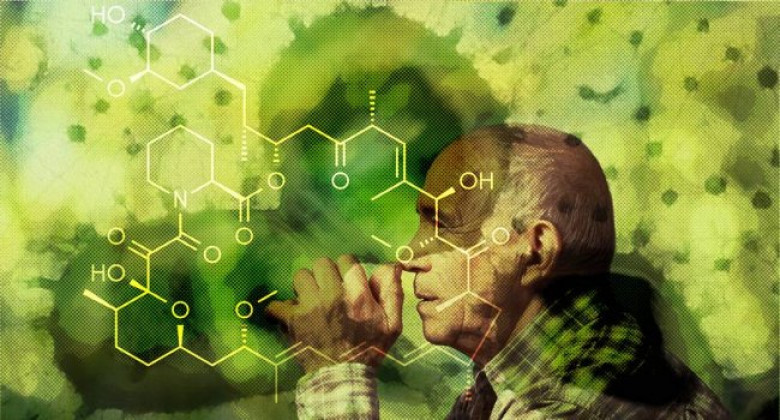New approach could be effective in treating Alzheimer's disease
ЛАЙФ
Tokyo's researchers have developed a new treatment for Alzheimer's disease that can successfully fight the accumulations of pathogenic amyloid proteins, a study published in the journal Brain reported.
According to MedicalXpress, amyloids are thought to be associated with neuronal death and severe symptoms in a deadly and still incurable form of dementia.
Scientists injected an oxygenation catalyst directly into the brains of living mice suffering from an analog of Alzheimer's disease and then activated it daily with a beam of light through the skull for 30 minutes. The therapy lasted one week. Analysis of the nerve tissue showed that the level of amyloid protein was significantly reduced.
The catalyst destabilizes amyloid plaques by attaching oxygen atoms to the pathogenic molecule, which changes chemical bonds in it. Certain parts of the molecule, called histidine residues, are crosslinked with each other, and the characteristic folded structure of the amyloid is destroyed. The catalyst remains inert until it is activated by light, whose wavelength is close to the infrared spectrum. The destabilized amyloid itself is removed by microglia, the immune cells of the brain.
The method allows you to fight amyloids not only in the human brain but throughout the body. The American Society of Clinical Oncology estimates that 4,000 people in the United States are diagnosed with a disease collectively known as amyloidosis each year. The photo-oxygenation catalyst is capable of removing amyloid protein regardless of when and where it was formed in the body.

 Трамп выразил надежду, что сможет положить конец украинскому конфликту
Трамп выразил надежду, что сможет положить конец украинскому конфликту Добыча полезных ископаемых — занятие не для глупых. «Паст».
Добыча полезных ископаемых — занятие не для глупых. «Паст». Team Holding объявляет о начале размещения облигаций. Андеррайтером выступает Freedom Broker Armenia
Team Holding объявляет о начале размещения облигаций. Андеррайтером выступает Freedom Broker Armenia Почему бывший министр обороны «заговорил сейчас»? «Паст».
Почему бывший министр обороны «заговорил сейчас»? «Паст». «Почему стрелы были направлены именно в адрес “того, кто разнимает драку”. «Паст»
«Почему стрелы были направлены именно в адрес “того, кто разнимает драку”. «Паст» «Это издевательство над государственностью». «Паст»
«Это издевательство над государственностью». «Паст» Юнибанк первым в Армении выпустил бессрочные облигации
Юнибанк первым в Армении выпустил бессрочные облигации
 Спорное положение закона – политическая дубинка. «Паст»
Спорное положение закона – политическая дубинка. «Паст» Пашинян против Церкви: вместо борьбы с кризисом — борьба с Католикосом: «Паст»
Пашинян против Церкви: вместо борьбы с кризисом — борьба с Католикосом: «Паст» Пашинян: Вопрос Нагорного Карабаха был решен в 1996 г, просто никто нам об этом не говорил
Пашинян: Вопрос Нагорного Карабаха был решен в 1996 г, просто никто нам об этом не говорил Bloomberg: ЕС поставляет в Нигерию запрещенные пестициды, вызывающие рак
Bloomberg: ЕС поставляет в Нигерию запрещенные пестициды, вызывающие рак Пашинян: В документах по Карабаху есть детали, которые способны вызывать международные проблемы
Пашинян: В документах по Карабаху есть детали, которые способны вызывать международные проблемы США приостановили прием иммиграционных заявлений из 19 стран после стрельбы у Белого дома
США приостановили прием иммиграционных заявлений из 19 стран после стрельбы у Белого дома Рютте: Австралия и Новая Зеландия подключились к закупкам оружия для Украины
Рютте: Австралия и Новая Зеландия подключились к закупкам оружия для Украины Проект «Россия с вами»: специальная партия гуманитарной помощи для переселенцев из Нагорного Карабаха доставлена в Эчмиадзин
Проект «Россия с вами»: специальная партия гуманитарной помощи для переселенцев из Нагорного Карабаха доставлена в Эчмиадзин
 Team Holding объявляет о начале размещения облигаций. Андеррайтером выступает Freedom Broker Armenia
Team Holding объявляет о начале размещения облигаций. Андеррайтером выступает Freedom Broker Armenia
 Минфин Армении: Расходы на нужды ряда министерств было решено увеличить
Минфин Армении: Расходы на нужды ряда министерств было решено увеличить Татоян: Пять уроков, которые следует извлечь из публикации документов, связанных с Арцахским конфликтом
Татоян: Пять уроков, которые следует извлечь из публикации документов, связанных с Арцахским конфликтом Безопасная авантюра без «парашюта». «Паст»
Безопасная авантюра без «парашюта». «Паст» Оформите зарплатную карту в Юнибанке — получите шанс выиграть 1 000 000 драмов
Оформите зарплатную карту в Юнибанке — получите шанс выиграть 1 000 000 драмов Euromoney признал Америабанк лучшим банком Армении в сфере недвижимости второй год подряд
Euromoney признал Америабанк лучшим банком Армении в сфере недвижимости второй год подряд
 Отныне не «спонтанно», а организованно. «Паст».
Отныне не «спонтанно», а организованно. «Паст». Откуда они взяли «голубиную» технологию? «Паст».
Откуда они взяли «голубиную» технологию? «Паст». Министр обороны РА принял участие в открытии выставки «EDEX 2025» в Египте
Министр обороны РА принял участие в открытии выставки «EDEX 2025» в Египте Аджапахян и Галстанян выступили с заявлением: Предлагаем прекратить полномочия непокорных предстоятелей
Аджапахян и Галстанян выступили с заявлением: Предлагаем прекратить полномочия непокорных предстоятелей Рейтинговое агентство S&P Global Ratings присвоило ЗАО «АйДи Банк» долгосрочный рейтинг «BB-» и краткосрочный рейтинг «B» со «стабильным» прогнозом
Рейтинговое агентство S&P Global Ratings присвоило ЗАО «АйДи Банк» долгосрочный рейтинг «BB-» и краткосрочный рейтинг «B» со «стабильным» прогнозом Цена серебра обновила рекорд - $57,86 за унцию
Цена серебра обновила рекорд - $57,86 за унцию В Ереване обрушилась часть здания бывшего фортепианного завода: есть пострадавший
В Ереване обрушилась часть здания бывшего фортепианного завода: есть пострадавший Заседание Антикоррупционного суда по делу о признанной антиконституционной статье продолжится 17 декабря
Заседание Антикоррупционного суда по делу о признанной антиконституционной статье продолжится 17 декабря Эдмон Марукян обратился к Католикосу всех армян: Прошу лишить сана Навасарда Кчояна
Эдмон Марукян обратился к Католикосу всех армян: Прошу лишить сана Навасарда Кчояна «Альтернативные проекты»: Очень часто сложные вопросы имеют простые решения
«Альтернативные проекты»: Очень часто сложные вопросы имеют простые решения Автодороги на территории Армении в основном открыты для проезда транспорта
Автодороги на территории Армении в основном открыты для проезда транспорта WSJ: на переговорах во Флориде обсуждается «обмен территориями» и выборы в Украине
WSJ: на переговорах во Флориде обсуждается «обмен территориями» и выборы в Украине SIPRI сообщил о рекордных доходах крупнейших производителей оружия в 2024 году
SIPRI сообщил о рекордных доходах крупнейших производителей оружия в 2024 году Волонтёры «Евразия-Армения» провели субботник в парке имени Комитаса
Волонтёры «Евразия-Армения» провели субботник в парке имени Комитаса  Вековая дружба армянского и русского народов: круглый стол с участием экспертов
Вековая дружба армянского и русского народов: круглый стол с участием экспертов
 Итальянский пианист Антонио ди Кристофано выступит с сольным концертом в Ереване и проведет мастер-классы для армянских пианистов
Итальянский пианист Антонио ди Кристофано выступит с сольным концертом в Ереване и проведет мастер-классы для армянских пианистов
 Почему Арман Татоян не участвовал в слушаниях по делу политзаключённых? «Паст»
Почему Арман Татоян не участвовал в слушаниях по делу политзаключённых? «Паст» Просто решили не возбуждать уголовное производство — и… всё. «Паст»
Просто решили не возбуждать уголовное производство — и… всё. «Паст» Где искать следы отмывания денег? «Паст»
Где искать следы отмывания денег? «Паст» Индийский миллиардер привезёт свои редкие Rolls-Royce на ралли классических автомобилей в ОАЭ
Индийский миллиардер привезёт свои редкие Rolls-Royce на ралли классических автомобилей в ОАЭ Фильм про адвоката Армена Мерджяна покажут на DOC NYC
Фильм про адвоката Армена Мерджяна покажут на DOC NYC В Русском доме в Ереване прошел круглый стол и презентация книги «Россия и Закавказье: история и культура»
В Русском доме в Ереване прошел круглый стол и презентация книги «Россия и Закавказье: история и культура»
 Песков: Россия ведёт переговоры по урегулированию на Украине только с США
Песков: Россия ведёт переговоры по урегулированию на Украине только с США Андрей Ермак подал в отставку с должности главы офиса президента Украины
Андрей Ермак подал в отставку с должности главы офиса президента Украины Активисты «Евразия-Армения» посетили Матенадаран: встреча с тысячелетним наследием
Активисты «Евразия-Армения» посетили Матенадаран: встреча с тысячелетним наследием Новый раздел в Idram&IDBank
Новый раздел в Idram&IDBank Несколько реальных и выгодных предложений в преддверии «Чёрной пятницы»: IDBank и Idram
Несколько реальных и выгодных предложений в преддверии «Чёрной пятницы»: IDBank и Idram Армянские спортсмены завоевали четыре медали на Сурдолимпийских играх 2025 в Токио
Армянские спортсмены завоевали четыре медали на Сурдолимпийских играх 2025 в Токио США намерены пересмотреть грин-карты, выданные лицам, иммигрировавшим из 19 стран
США намерены пересмотреть грин-карты, выданные лицам, иммигрировавшим из 19 стран 





